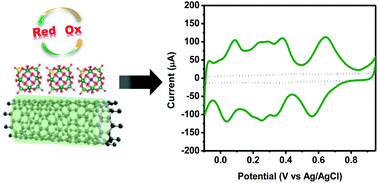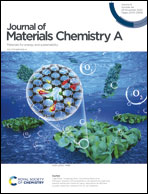Layer-by-layer assembly of inorganic–organic molybdovanadogermanic (GeMoV)-polyluminol composite electrodes for capacitive charge storage†
Abstract
Electrode materials composed of carbon nanotubes (CNTs) modified by a Keggin-type polyoxometalate (molybdovanadogermanic anions, GeMoV), electrochemically active chemically polymerized polyluminol (CpLum), and polydiallyldimethylammonium (PDDA) polycations were developed via a layer-by-layer (LbL) deposition process. The composite electrodes, with 5–6 nm inorganic–organic coatings, demonstrated a uniquely combined electrochemical redox behavior, enhanced charge storage capacity, high rate performance and good cycling stability. The synergistic interaction among the three components resulted in fast kinetic capacitive contribution over the respective single component modified CNT electrodes. The surfaces of the composites were investigated using X-ray photoelectron spectroscopy and revealed that the CpLum and PDDA polymers bonded with GeMoV via N+O− electrostatic interactions. Within the inorganic–organic layers, the GeMoV anions exhibited fast and highly reversible electrochemical redox activities in both higher and lower potential regions. Both PDDA and CpLum organic layers acted as anchors for the GeMoV anion on the CNT surface. CpLum also contributed to the redox processes in charge storage while improving the overall reaction kinetics.



 Please wait while we load your content...
Please wait while we load your content...